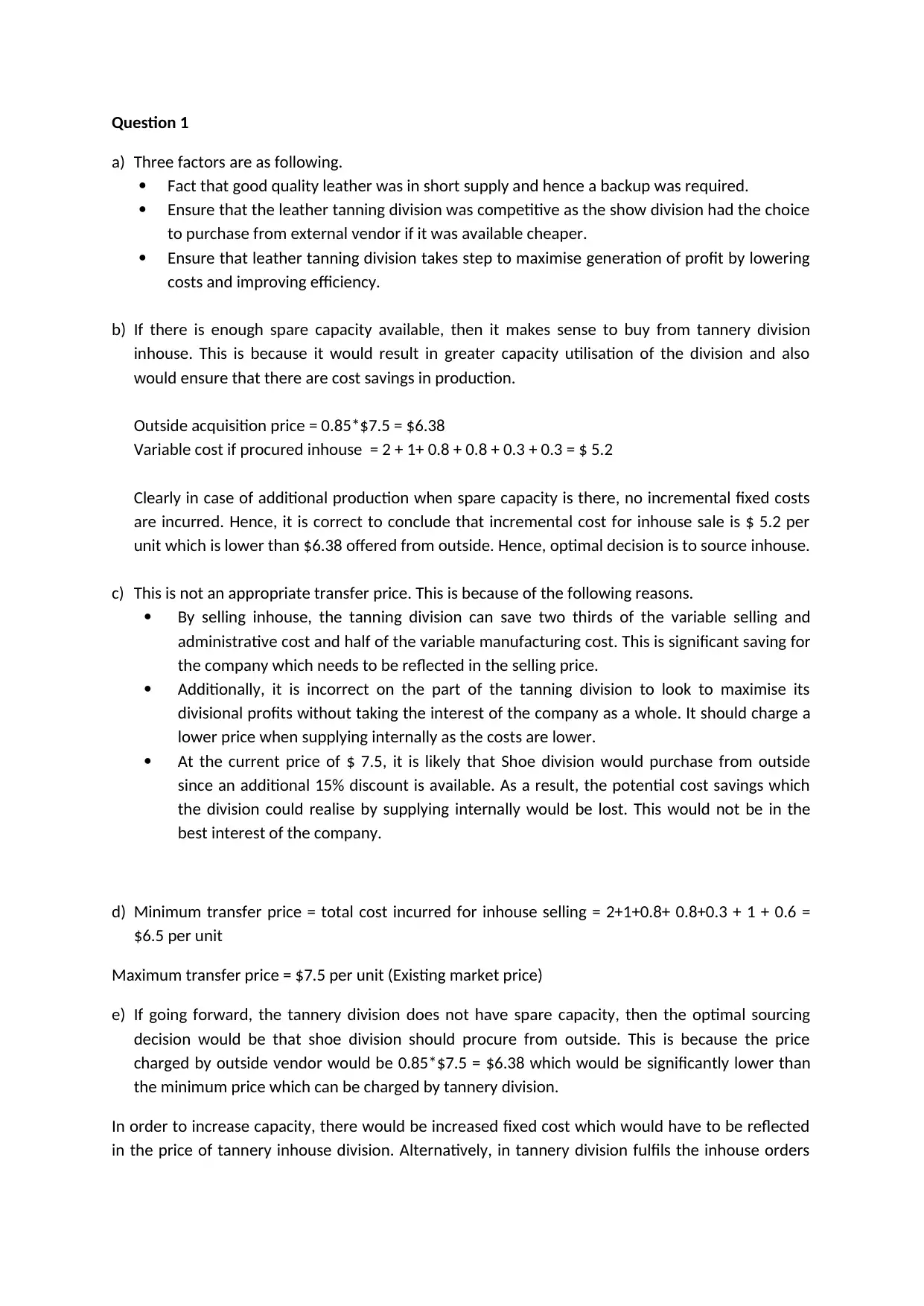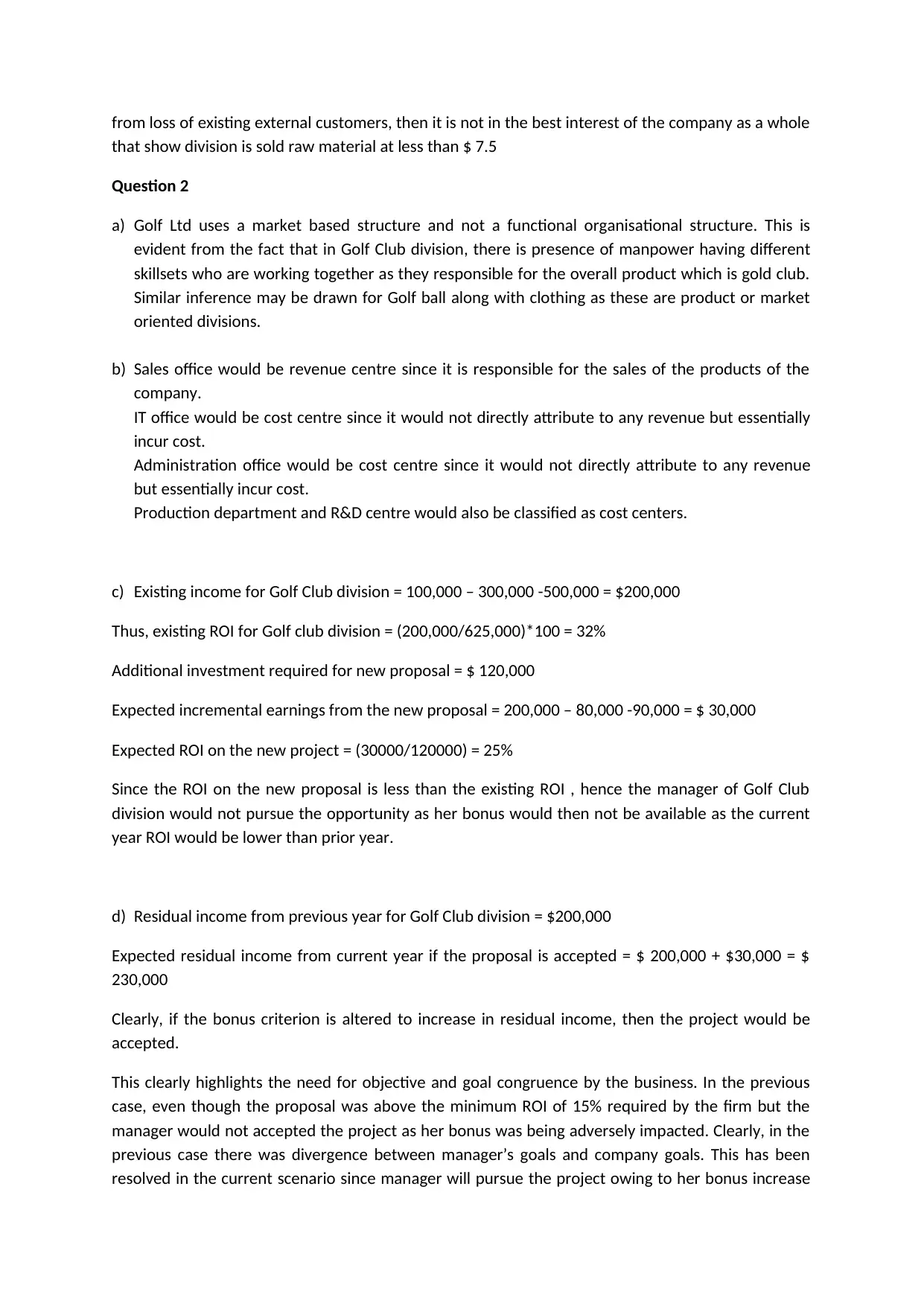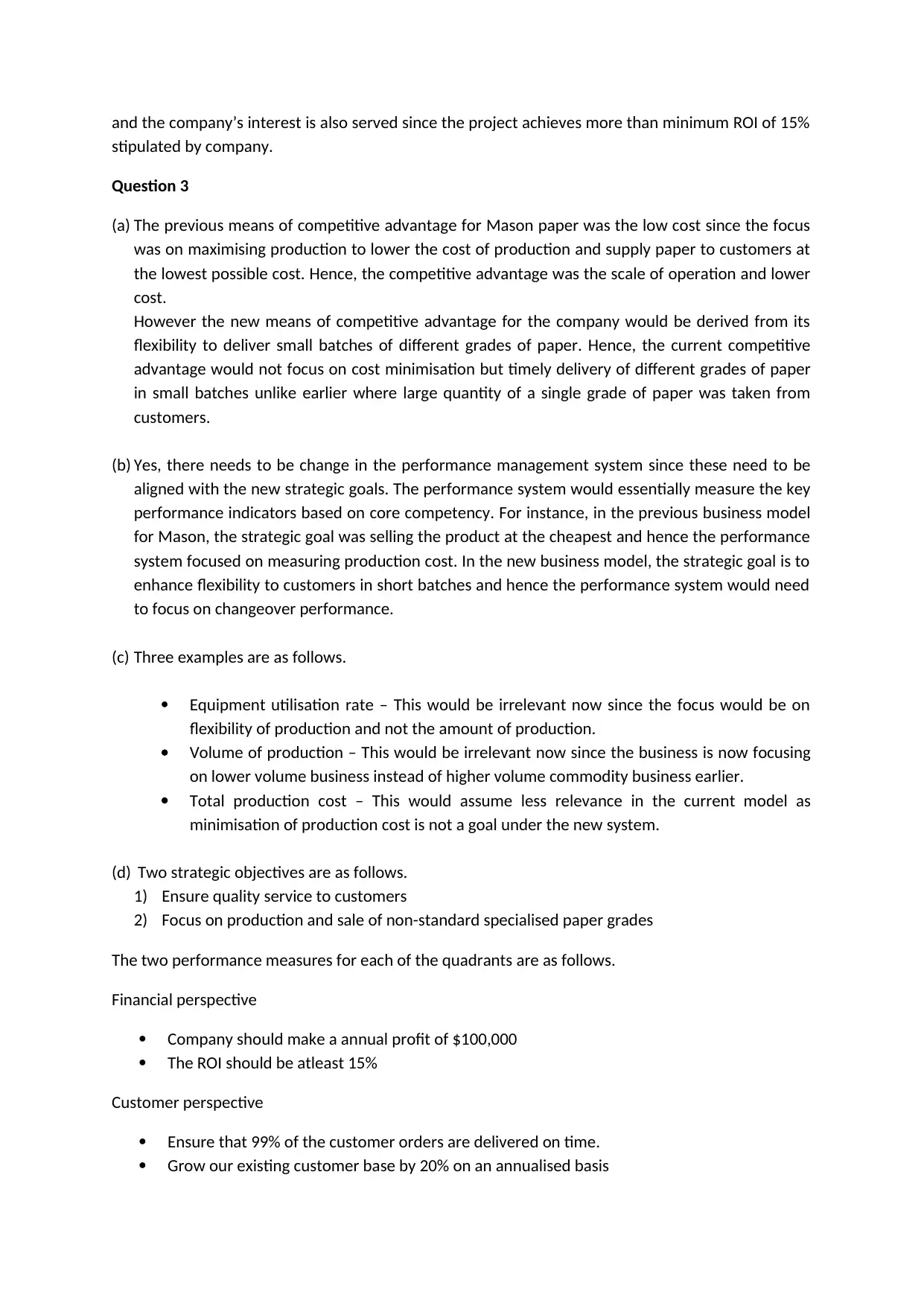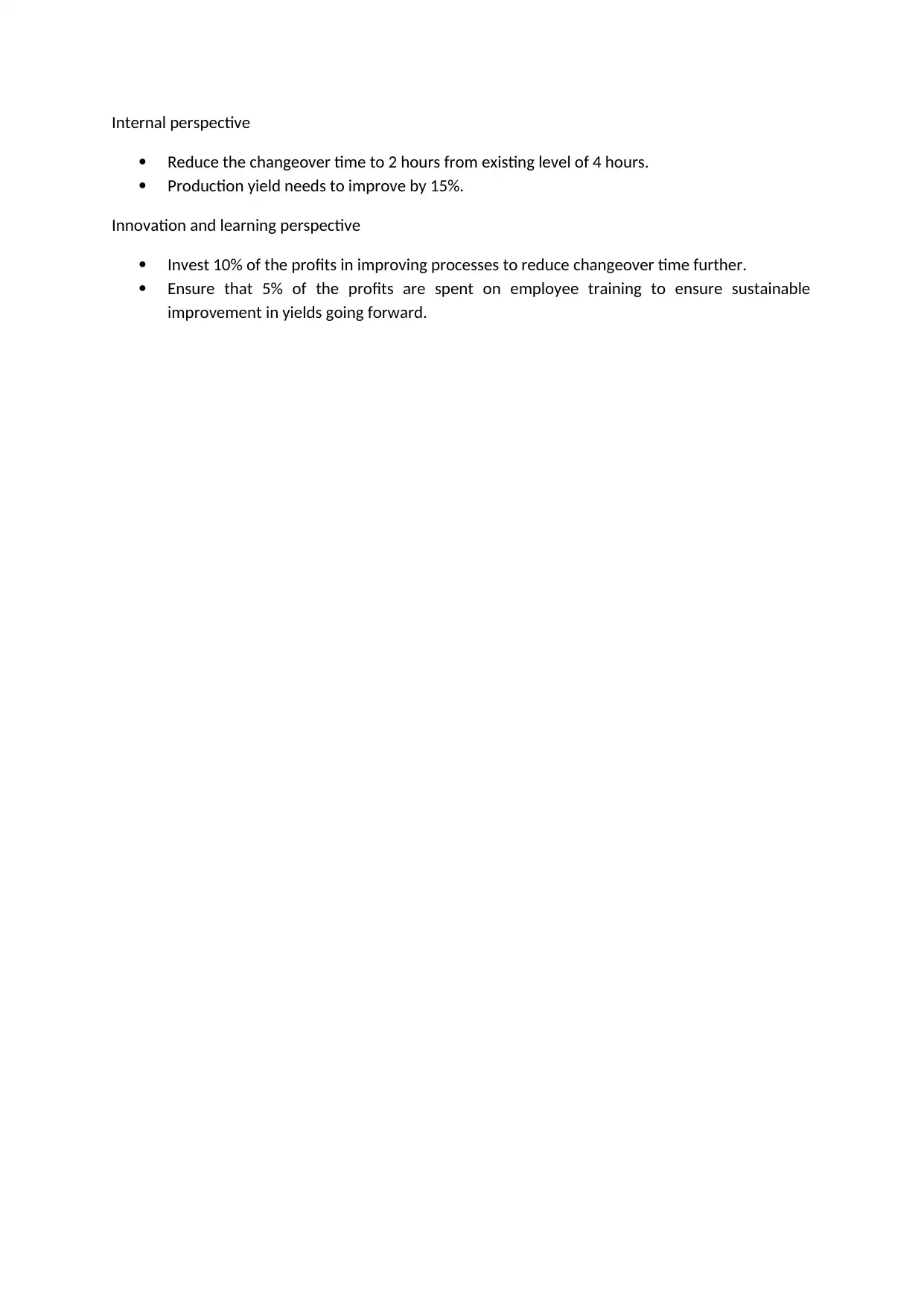generation of profit by lowering costs
VerifiedAdded on 2022/07/28
|4
|1404
|41
AI Summary
- Please answer questions in simple English. - No need for reference - No need to insert tables or diagrams - Workings are required for calculation questions - Please use the notes given and do not use lift words from the notes to answer the exam questions - The possible chapters I think will be tested are these chapters: Topic 1: Introduction to Management Accounting Systems (MAS) and the Importance of Business Strategy to MAS Design Week 2: Organisational Structure and Responsibility Accounting Week 7: Financial Performance Measurement Week 10: The Balanced Scorecard Week 9: Transfer Pricing - This paper is worth 50 marks - You can use this link to access lecture notes, practice question and its solutions: https://www.dropbox.com/sh/ch5p9x7y28rnbau/AACSrqjnBnzaTxnd0uSeTE2ya/Revision?dl=0&subfolder_nav_tracking=1
Contribute Materials
Your contribution can guide someone’s learning journey. Share your
documents today.

Question 1
a) Three factors are as following.
Fact that good quality leather was in short supply and hence a backup was required.
Ensure that the leather tanning division was competitive as the show division had the choice
to purchase from external vendor if it was available cheaper.
Ensure that leather tanning division takes step to maximise generation of profit by lowering
costs and improving efficiency.
b) If there is enough spare capacity available, then it makes sense to buy from tannery division
inhouse. This is because it would result in greater capacity utilisation of the division and also
would ensure that there are cost savings in production.
Outside acquisition price = 0.85*$7.5 = $6.38
Variable cost if procured inhouse = 2 + 1+ 0.8 + 0.8 + 0.3 + 0.3 = $ 5.2
Clearly in case of additional production when spare capacity is there, no incremental fixed costs
are incurred. Hence, it is correct to conclude that incremental cost for inhouse sale is $ 5.2 per
unit which is lower than $6.38 offered from outside. Hence, optimal decision is to source inhouse.
c) This is not an appropriate transfer price. This is because of the following reasons.
By selling inhouse, the tanning division can save two thirds of the variable selling and
administrative cost and half of the variable manufacturing cost. This is significant saving for
the company which needs to be reflected in the selling price.
Additionally, it is incorrect on the part of the tanning division to look to maximise its
divisional profits without taking the interest of the company as a whole. It should charge a
lower price when supplying internally as the costs are lower.
At the current price of $ 7.5, it is likely that Shoe division would purchase from outside
since an additional 15% discount is available. As a result, the potential cost savings which
the division could realise by supplying internally would be lost. This would not be in the
best interest of the company.
d) Minimum transfer price = total cost incurred for inhouse selling = 2+1+0.8+ 0.8+0.3 + 1 + 0.6 =
$6.5 per unit
Maximum transfer price = $7.5 per unit (Existing market price)
e) If going forward, the tannery division does not have spare capacity, then the optimal sourcing
decision would be that shoe division should procure from outside. This is because the price
charged by outside vendor would be 0.85*$7.5 = $6.38 which would be significantly lower than
the minimum price which can be charged by tannery division.
In order to increase capacity, there would be increased fixed cost which would have to be reflected
in the price of tannery inhouse division. Alternatively, in tannery division fulfils the inhouse orders
a) Three factors are as following.
Fact that good quality leather was in short supply and hence a backup was required.
Ensure that the leather tanning division was competitive as the show division had the choice
to purchase from external vendor if it was available cheaper.
Ensure that leather tanning division takes step to maximise generation of profit by lowering
costs and improving efficiency.
b) If there is enough spare capacity available, then it makes sense to buy from tannery division
inhouse. This is because it would result in greater capacity utilisation of the division and also
would ensure that there are cost savings in production.
Outside acquisition price = 0.85*$7.5 = $6.38
Variable cost if procured inhouse = 2 + 1+ 0.8 + 0.8 + 0.3 + 0.3 = $ 5.2
Clearly in case of additional production when spare capacity is there, no incremental fixed costs
are incurred. Hence, it is correct to conclude that incremental cost for inhouse sale is $ 5.2 per
unit which is lower than $6.38 offered from outside. Hence, optimal decision is to source inhouse.
c) This is not an appropriate transfer price. This is because of the following reasons.
By selling inhouse, the tanning division can save two thirds of the variable selling and
administrative cost and half of the variable manufacturing cost. This is significant saving for
the company which needs to be reflected in the selling price.
Additionally, it is incorrect on the part of the tanning division to look to maximise its
divisional profits without taking the interest of the company as a whole. It should charge a
lower price when supplying internally as the costs are lower.
At the current price of $ 7.5, it is likely that Shoe division would purchase from outside
since an additional 15% discount is available. As a result, the potential cost savings which
the division could realise by supplying internally would be lost. This would not be in the
best interest of the company.
d) Minimum transfer price = total cost incurred for inhouse selling = 2+1+0.8+ 0.8+0.3 + 1 + 0.6 =
$6.5 per unit
Maximum transfer price = $7.5 per unit (Existing market price)
e) If going forward, the tannery division does not have spare capacity, then the optimal sourcing
decision would be that shoe division should procure from outside. This is because the price
charged by outside vendor would be 0.85*$7.5 = $6.38 which would be significantly lower than
the minimum price which can be charged by tannery division.
In order to increase capacity, there would be increased fixed cost which would have to be reflected
in the price of tannery inhouse division. Alternatively, in tannery division fulfils the inhouse orders
Secure Best Marks with AI Grader
Need help grading? Try our AI Grader for instant feedback on your assignments.

from loss of existing external customers, then it is not in the best interest of the company as a whole
that show division is sold raw material at less than $ 7.5
Question 2
a) Golf Ltd uses a market based structure and not a functional organisational structure. This is
evident from the fact that in Golf Club division, there is presence of manpower having different
skillsets who are working together as they responsible for the overall product which is gold club.
Similar inference may be drawn for Golf ball along with clothing as these are product or market
oriented divisions.
b) Sales office would be revenue centre since it is responsible for the sales of the products of the
company.
IT office would be cost centre since it would not directly attribute to any revenue but essentially
incur cost.
Administration office would be cost centre since it would not directly attribute to any revenue
but essentially incur cost.
Production department and R&D centre would also be classified as cost centers.
c) Existing income for Golf Club division = 100,000 – 300,000 -500,000 = $200,000
Thus, existing ROI for Golf club division = (200,000/625,000)*100 = 32%
Additional investment required for new proposal = $ 120,000
Expected incremental earnings from the new proposal = 200,000 – 80,000 -90,000 = $ 30,000
Expected ROI on the new project = (30000/120000) = 25%
Since the ROI on the new proposal is less than the existing ROI , hence the manager of Golf Club
division would not pursue the opportunity as her bonus would then not be available as the current
year ROI would be lower than prior year.
d) Residual income from previous year for Golf Club division = $200,000
Expected residual income from current year if the proposal is accepted = $ 200,000 + $30,000 = $
230,000
Clearly, if the bonus criterion is altered to increase in residual income, then the project would be
accepted.
This clearly highlights the need for objective and goal congruence by the business. In the previous
case, even though the proposal was above the minimum ROI of 15% required by the firm but the
manager would not accepted the project as her bonus was being adversely impacted. Clearly, in the
previous case there was divergence between manager’s goals and company goals. This has been
resolved in the current scenario since manager will pursue the project owing to her bonus increase
that show division is sold raw material at less than $ 7.5
Question 2
a) Golf Ltd uses a market based structure and not a functional organisational structure. This is
evident from the fact that in Golf Club division, there is presence of manpower having different
skillsets who are working together as they responsible for the overall product which is gold club.
Similar inference may be drawn for Golf ball along with clothing as these are product or market
oriented divisions.
b) Sales office would be revenue centre since it is responsible for the sales of the products of the
company.
IT office would be cost centre since it would not directly attribute to any revenue but essentially
incur cost.
Administration office would be cost centre since it would not directly attribute to any revenue
but essentially incur cost.
Production department and R&D centre would also be classified as cost centers.
c) Existing income for Golf Club division = 100,000 – 300,000 -500,000 = $200,000
Thus, existing ROI for Golf club division = (200,000/625,000)*100 = 32%
Additional investment required for new proposal = $ 120,000
Expected incremental earnings from the new proposal = 200,000 – 80,000 -90,000 = $ 30,000
Expected ROI on the new project = (30000/120000) = 25%
Since the ROI on the new proposal is less than the existing ROI , hence the manager of Golf Club
division would not pursue the opportunity as her bonus would then not be available as the current
year ROI would be lower than prior year.
d) Residual income from previous year for Golf Club division = $200,000
Expected residual income from current year if the proposal is accepted = $ 200,000 + $30,000 = $
230,000
Clearly, if the bonus criterion is altered to increase in residual income, then the project would be
accepted.
This clearly highlights the need for objective and goal congruence by the business. In the previous
case, even though the proposal was above the minimum ROI of 15% required by the firm but the
manager would not accepted the project as her bonus was being adversely impacted. Clearly, in the
previous case there was divergence between manager’s goals and company goals. This has been
resolved in the current scenario since manager will pursue the project owing to her bonus increase

and the company’s interest is also served since the project achieves more than minimum ROI of 15%
stipulated by company.
Question 3
(a) The previous means of competitive advantage for Mason paper was the low cost since the focus
was on maximising production to lower the cost of production and supply paper to customers at
the lowest possible cost. Hence, the competitive advantage was the scale of operation and lower
cost.
However the new means of competitive advantage for the company would be derived from its
flexibility to deliver small batches of different grades of paper. Hence, the current competitive
advantage would not focus on cost minimisation but timely delivery of different grades of paper
in small batches unlike earlier where large quantity of a single grade of paper was taken from
customers.
(b) Yes, there needs to be change in the performance management system since these need to be
aligned with the new strategic goals. The performance system would essentially measure the key
performance indicators based on core competency. For instance, in the previous business model
for Mason, the strategic goal was selling the product at the cheapest and hence the performance
system focused on measuring production cost. In the new business model, the strategic goal is to
enhance flexibility to customers in short batches and hence the performance system would need
to focus on changeover performance.
(c) Three examples are as follows.
Equipment utilisation rate – This would be irrelevant now since the focus would be on
flexibility of production and not the amount of production.
Volume of production – This would be irrelevant now since the business is now focusing
on lower volume business instead of higher volume commodity business earlier.
Total production cost – This would assume less relevance in the current model as
minimisation of production cost is not a goal under the new system.
(d) Two strategic objectives are as follows.
1) Ensure quality service to customers
2) Focus on production and sale of non-standard specialised paper grades
The two performance measures for each of the quadrants are as follows.
Financial perspective
Company should make a annual profit of $100,000
The ROI should be atleast 15%
Customer perspective
Ensure that 99% of the customer orders are delivered on time.
Grow our existing customer base by 20% on an annualised basis
stipulated by company.
Question 3
(a) The previous means of competitive advantage for Mason paper was the low cost since the focus
was on maximising production to lower the cost of production and supply paper to customers at
the lowest possible cost. Hence, the competitive advantage was the scale of operation and lower
cost.
However the new means of competitive advantage for the company would be derived from its
flexibility to deliver small batches of different grades of paper. Hence, the current competitive
advantage would not focus on cost minimisation but timely delivery of different grades of paper
in small batches unlike earlier where large quantity of a single grade of paper was taken from
customers.
(b) Yes, there needs to be change in the performance management system since these need to be
aligned with the new strategic goals. The performance system would essentially measure the key
performance indicators based on core competency. For instance, in the previous business model
for Mason, the strategic goal was selling the product at the cheapest and hence the performance
system focused on measuring production cost. In the new business model, the strategic goal is to
enhance flexibility to customers in short batches and hence the performance system would need
to focus on changeover performance.
(c) Three examples are as follows.
Equipment utilisation rate – This would be irrelevant now since the focus would be on
flexibility of production and not the amount of production.
Volume of production – This would be irrelevant now since the business is now focusing
on lower volume business instead of higher volume commodity business earlier.
Total production cost – This would assume less relevance in the current model as
minimisation of production cost is not a goal under the new system.
(d) Two strategic objectives are as follows.
1) Ensure quality service to customers
2) Focus on production and sale of non-standard specialised paper grades
The two performance measures for each of the quadrants are as follows.
Financial perspective
Company should make a annual profit of $100,000
The ROI should be atleast 15%
Customer perspective
Ensure that 99% of the customer orders are delivered on time.
Grow our existing customer base by 20% on an annualised basis

Internal perspective
Reduce the changeover time to 2 hours from existing level of 4 hours.
Production yield needs to improve by 15%.
Innovation and learning perspective
Invest 10% of the profits in improving processes to reduce changeover time further.
Ensure that 5% of the profits are spent on employee training to ensure sustainable
improvement in yields going forward.
Reduce the changeover time to 2 hours from existing level of 4 hours.
Production yield needs to improve by 15%.
Innovation and learning perspective
Invest 10% of the profits in improving processes to reduce changeover time further.
Ensure that 5% of the profits are spent on employee training to ensure sustainable
improvement in yields going forward.
1 out of 4
Your All-in-One AI-Powered Toolkit for Academic Success.
+13062052269
info@desklib.com
Available 24*7 on WhatsApp / Email
![[object Object]](/_next/static/media/star-bottom.7253800d.svg)
Unlock your academic potential
© 2024 | Zucol Services PVT LTD | All rights reserved.